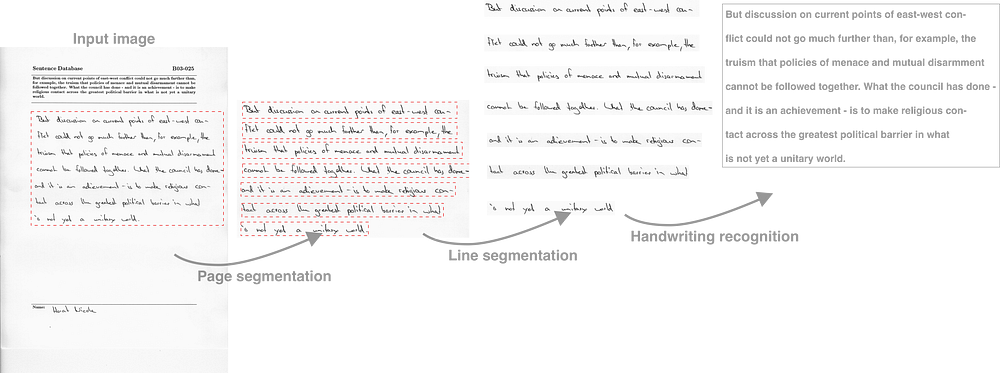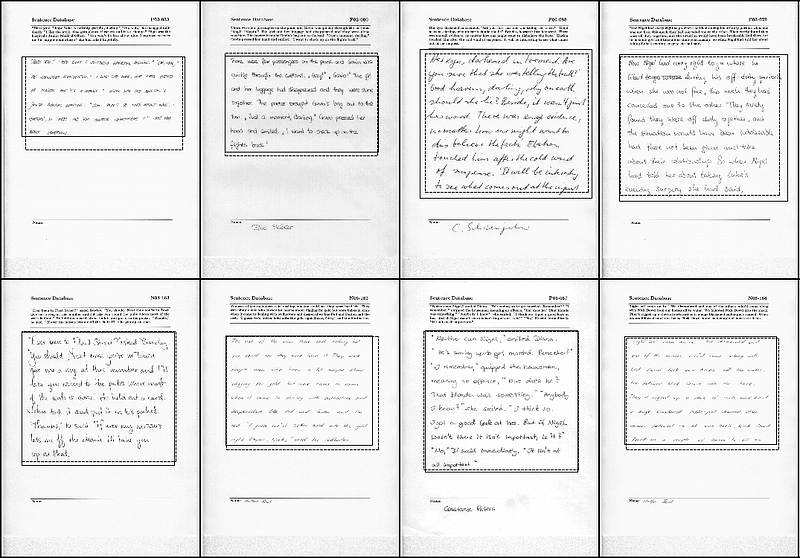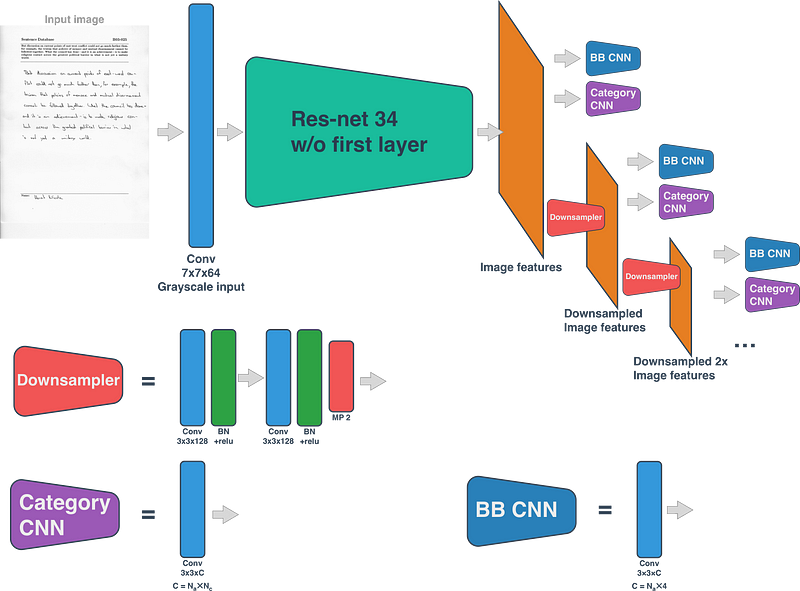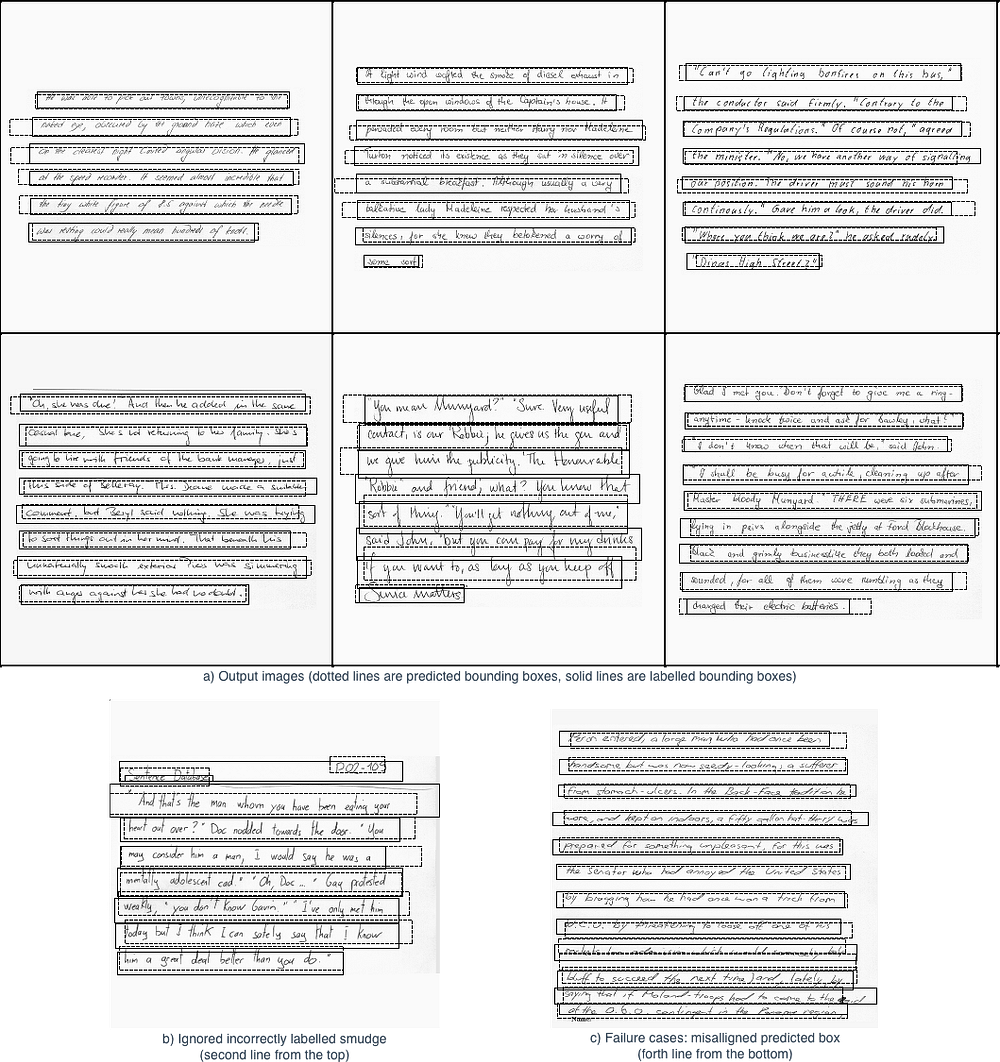These notebooks have been created by Jonathan Chung, as part of his internship as Applied Scientist @ Amazon AI, in collaboration with Thomas Delteil who built the original prototype.
Parameters:
Handwritten Text Recognization in one step
image: input image in numpy.array object that includes handwritten text
form_size: possible form size
device:
If it is None:
If num_device==1: uses gpu if there is any gpu
else: uses num_device gpu if there is any gpu
If it is 'auto':
If num_device==1: uses gpu if there is any gpu
else: uses num_device gpu if there is any gpu
if it is 'cpu': uses one, num_device-1 indexed cpu
if it is 'gpu': uses one, num_device-1 indexed gpu
num_device: number of device that module running on.
cropping detected text area
ScliteHelperPATH: Tool that helps to get quantitative results. https://github.com/usnistgov/SCTK
show: Show plot if show=True. default; show=False
is_test: If it is True than activate SCTK tool to get quantative results.
recognize Usage:
image = mx.image.imread("tests/TurkishHandwritten/elyaz2.jpeg")
image = image.asnumpy()
recog = recognize(image, device=device)
result = recog()
recognize class returns:
results = {
'predicted_text_area': predicted_text_area,
'croped_image': croped_image,
'predicted_bb': predicted_bb,
'line_images_array': line_images_array,
'character_probs': character_probs,
'decoded': decoded
}
recognize_test Usage:
htr_test = recognize_test(show=True, device=device)
result = htr_test()
recognize_IAM_random_test Usage:
IAM_recog = recognize_IAM_random_test(device)
result = IAM_recog()
recognize_IAM_random_test Usage:
IAM_recog = recognize_IAM_random_test(device)
result = IAM_recog()
scikit_image
scipy
matplotlib
tqdm
mxnet_cu102mkl
pandas
nltk
mxboard
numpy
gluonnlp
leven
ipython
mxnet
mxboard
Pillow
pyenchant
scikit-image
sympound
weighted_levenshtein
hnswlib
pybind11
setuptools
pdoc3
pprint
"""
git clone https://github.com/develooper1994/handwritten-text-recognition --recursive
You need to install SCLITE for WER evaluation You can follow the following bash script from this folder:
cd ..
git clone https://github.com/usnistgov/SCTK
cd SCTK
export CXXFLAGS="-std=c++11" && make config
make all
make check
make install
make doc
cd -You also need hsnwlib
pip install pybind11 numpy setuptools
pip install hnswlibThe pipeline is composed of 3 steps:
- Detecting the handwritten area in a form [blog post], [jupyter notebook], [python script]
- Detecting lines of handwritten texts [blog post], [jupyter notebook], [python script]
- Recognising characters and applying a language model to correct errors. [blog post], [jupyter notebook], [python script]
The entire inference pipeline can be found in this notebook. See the pretrained models section for the pretrained models.
A recorded talk detailing the approach is available on youtube. [video]
The corresponding slides are available on slideshare. [slides]
You can get the models by running python get_models.py:
The greedy, lexicon search, and beam search outputs present similar and reasonable predictions for the selected examples. In Figure 6, interesting examples are presented. The first line of Figure 6 show cases where the lexicon search algorithm provided fixes that corrected the words. In the top example, “tovely” (as it was written) was corrected “lovely” and “woved” was corrected to “waved”. In addition, the beam search output corrected “a” into “all”, however it missed a space between “lovely” and “things”. In the second example, “selt” was converted to “salt” with the lexicon search output. However, “selt” was erroneously converted to “self” in the beam search output. Therefore, in this example, beam search performed worse. In the third example, none of the three methods significantly provided comprehensible results. Finally, in the forth example, the lexicon search algorithm incorrectly converted “forhim” into “forum”, however the beam search algorithm correctly identified “for him”.
-
To use test_iam_dataset.ipynb, create credentials.json using credentials.json.example and editing the appropriate field. The username and password can be obtained from http://www.fki.inf.unibe.ch/DBs/iamDB/iLogin/index.php.
-
It is recommended to use an instance with 32GB+ RAM and 100GB disk size, a GPU is also recommended. A p3.2xlarge would be the recommended starter instance on AWS for this project
At leats 11GB VRAM GPU or 11GB space on RAM.
https://pythonawesome.com/handwritten-text-recognition-ocr-with-mxnet-gluon/ https://www.youtube.com/watch?v=xDcOdif4lj0&t=1281s https://github.com/awslabs/handwritten-text-recognition-for-apache-mxnet
https://rrc.cvc.uab.es/ https://www.pyimagesearch.com/2018/08/20/opencv-text-detection-east-text-detector/
Handwriting reading process is developing gradually.
- Read "born digital"
- Read printed "born digital"
- Read handwritten by tablet or any input device
- Handwritten recorded under perfect conditions
- Ability to read horizontally
- Crowded historical texts
- Signage etc. perception
- .......
- Extract information from video taken in the wilderness
or in the city (without any prior correction, like human)






